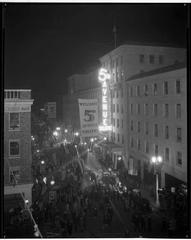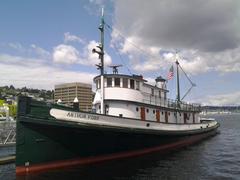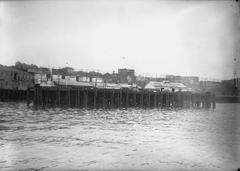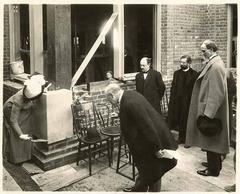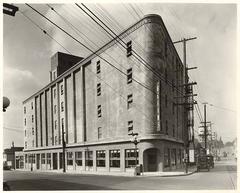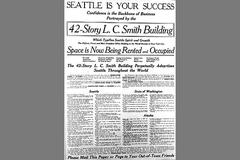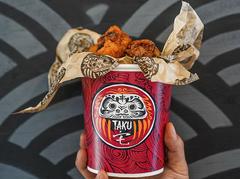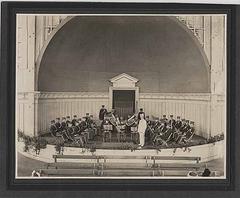Maneki Seattle: Visiting Hours, Tickets & Historical Sites Guide
Date: 04/07/2025
Introduction: Maneki Seattle’s Legacy
Nestled in the heart of Seattle’s Chinatown-International District, Maneki is more than just Seattle’s oldest Japanese restaurant—it is a living emblem of Japanese-American heritage and resilience. Since opening its doors in 1904, Maneki has served as a vibrant community hub, weathering the storms of history from early immigration waves and World War II internment to recent challenges like the COVID-19 pandemic. Its enduring presence reflects a dedication to authentic Japanese cuisine, heartfelt hospitality, and cultural preservation. This guide offers a comprehensive overview of Maneki’s history, visiting hours, reservation tips, accessibility insights, menu highlights, and recommendations for exploring nearby historical sites (Seattle Met; Noms Magazine; RestaurantJump).
Table of Contents
- History and Cultural Significance
- Visitor Information
- Ambiance & Menu Highlights
- Practical Tips & Nearby Attractions
- Frequently Asked Questions (FAQ)
- Visual Gallery
- Related Seattle Historical Sites
- Conclusion
- Sources
History and Cultural Significance
Founding and Early Years
Established in 1904, Maneki originally stood as a three-story “castle” in Seattle’s burgeoning Nihonmachi (Japantown), offering a gathering place for Japanese immigrants to celebrate community, culture, and cuisine. Featuring Seattle’s first sushi bar, traditional tatami rooms, and a varied menu, Maneki quickly became a social anchor, hosting theatrical performances and community events (Seattle Met).
Surviving Historical Adversity
The restaurant’s journey has not been without hardship. During World War II, Maneki was forced to close as Japanese Americans faced incarceration under Executive Order 9066. Post-war, the community’s determination saw Maneki reopen in a new location within the International District, symbolizing resilience and continuity.
Leadership and Community Anchor
Over the decades, Maneki has been shepherded by dedicated stewards, notably Jean Nakayama and Fusae “Mom” Yokoyama, whose leadership and warmth have preserved the restaurant’s welcoming ethos through changing times. Even in periods of crisis, such as the COVID-19 pandemic, Maneki adapted creatively—offering takeout and modifying its menu to ensure the safety and satisfaction of its patrons (Seattle Met).
Cultural Impact and Recognition
Maneki’s significance extends beyond its longevity. It is a symbol of hope, endurance, and cross-cultural connection—recognized as one of Seattle’s most beloved institutions and frequently featured in local and national accolades (Noms Magazine).
Visitor Information
Visiting Hours
- Tuesday – Sunday: 5:30 pm – 10:30 pm
- Closed Mondays & select holidays
Note: Hours may vary during holidays or special events. Always check the official website before visiting.
Reservations
- Strongly recommended due to high demand, especially for tatami rooms and weekends.
- How to reserve:
- Online via Maneki’s reservation page
- By phone: +1 206-622-2631
- For select dates: Text (503) 662-2814 (Maneki Seattle)
- Walk-ins: Accepted, but expect long waits during peak hours.
Accessibility
- Wheelchair accessible: Ramps and accessible restrooms are available.
- Tatami rooms: Feature traditional floor seating; may not be suitable for all mobility needs. Inquire when booking.
Getting There & Parking
- Address: 304 6th Ave S, Seattle, WA 98104
- Public Transit:
- Link Light Rail (International District/Chinatown Station)
- Multiple bus routes
- Parking:
- Limited street parking
- Nearby paid lots (reserve via SpotHero)
- Rideshare or public transit recommended
Ambiance & Menu Highlights
Ambiance
Maneki’s inviting interior blends Japanese tradition and Seattle history. The restaurant features light wooden accents, paper lanterns, and walls adorned with Japanese art and memorabilia, creating an immersive setting. Private tatami rooms offer a serene, authentic experience, while a lively main dining area accommodates solo diners and groups alike (Noms Magazine; Two Hungry Blokes).
Menu Highlights
- Signature Dishes:
- Miso-marinated black cod collar
- Agedashi tofu
- Saba Ichiya Boshi (salt-rubbed grilled mackerel)
- Salmon Nanban (fried salmon in vinegar sauce)
- Jojo Roll (freshwater eel, cucumber, radish sprouts)
- Sushi & Sashimi: Daily specials featuring wild salmon, king salmon, chu-toro, and more.
- Vegetarian & Gluten-Free Options: Available—inform your server of dietary needs.
Service & Hospitality
True to the Japanese principle of omotenashi, Maneki’s staff provide attentive, knowledgeable, and warm service, ensuring every guest feels welcome and cared for.
Practical Tips & Nearby Attractions
Tips for Visiting
- Book early: Reservations open two weeks in advance and fill quickly.
- Arrive on time: Late arrivals may forfeit reservations during busy periods.
- Dress code: Casual but respectful, especially in tatami rooms (wear clean socks).
- Photo etiquette: Allowed, but ask before photographing staff or other guests.
Nearby Attractions
- Wing Luke Museum: Celebrating Asian Pacific American history (Wing Luke Museum)
- Uwajimaya Market: Renowned Asian grocery and gift shop
- Seattle Chinatown Historic District: Explore local shops, bakeries, and cultural landmarks (Seattle Chinatown Historic District)
- Downtown Seattle: Pike Place Market, Seattle Art Museum, and waterfront are a short trip away (Secret Seattle)
Frequently Asked Questions (FAQ)
Q: What are Maneki’s hours?
A: Tuesday–Sunday, 5:30 pm–10:30 pm; closed Mondays. Hours may vary on holidays.
Q: How do I make a reservation?
A: Reserve online, by phone, or via text (see above for details).
Q: Is there an entrance fee?
A: No. You pay only for your meal.
Q: Is Maneki wheelchair accessible?
A: Yes, but tatami rooms have floor seating and may not suit all guests.
Q: Are vegetarian and gluten-free options available?
A: Yes, with advance notice to staff.
Q: Can I take photos?
A: Yes, with respect for other guests and staff.
Visual Gallery
Explore a virtual tour of Maneki.
Related Seattle Historical Sites
Conclusion
Maneki is not just a restaurant—it is a cornerstone of Seattle’s multicultural heritage, a living museum of Japanese-American perseverance, and a beloved dining destination. With its storied history, authentic menu, and welcoming ambiance, Maneki offers a truly memorable experience for anyone interested in culture, cuisine, or community. Book your visit in advance, explore nearby historical sites, and immerse yourself in the legacy of this Seattle institution.
For more insights into Seattle’s food and culture, download the Audiala app and follow our updates on social media.
Sources and Further Reading
- Seattle Met
- Noms Magazine
- RestaurantJump
- Maneki Seattle Official Website
- Two Hungry Blokes
- Wing Luke Museum
- Secret Seattle
- SpotHero
